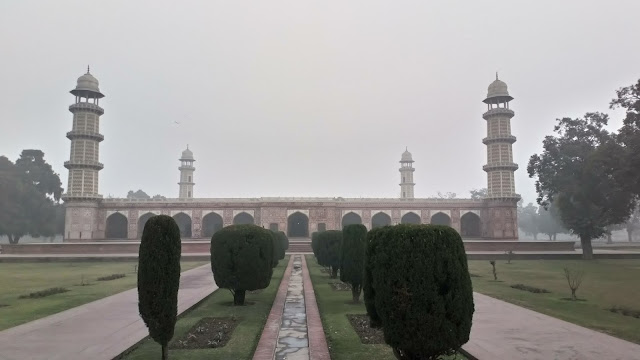'Mughal Era Special'
All These Photographs are Of English/Urdu Commemorative Board And Great Mughal Times Beautiful Building Of The Mausoleum of Mughal Emperor Jahangir Located Inside Bagh-e-Dil Kusha at Shahdara, Lahore, Punjab, Pakistan. The tomb was built and completed by Emperor Shah Jahan at the cost of one million rupees in 1637 A. D.
It is written in English on the Commemorative Board Erected at The Tomb of Emperor Jahangir.
'Jahangir 's Tomb'
'Jahangir the fourth Mughal Emperor Of India died in (1627 AD) at Rajauri on his way back From Kashmir to Lahore. He was buried in a spacious walled Garden of Empress Noor Jahan called Bagh-e-Dil Kusha at Shahdara on the river Ravi five kms North West of then city of Lahore. His tomb was built and completed by Emperor Shah Jahan at the cost of one million rupees in (1637 A. D). The garden Measures 1538 ×1538 feet. The tomb is Monument of surprising beauty and the finest ornament of Historical Lahore and is considered the most magnificent Mughal edifice in the Indo-Pak Sub-continent after the Taj Mahal at Agra. The tomb is a single storey structure, square in plan with about 267 feet, consists of a platform with tall octagonal corner towers and a projected entrance in middle of each side. The exterior side of the Monument, including the The lowest stage of tower has a red sand stone facing with rich panels decoration inlaid with morble decorative Motifs. The four corner towers with white marble cupolas rise in five stages to a height of hundred feet with zigzag inlay of white and yellow marble. The building is divided into the series of vaulted compartment. The interior is embellished with floral fresco delicate inlay work pietradura and brilliant marble intarsia of various colours. The marble cenotaphs with its delicate and colorful pietradura is engraved with the ninety attributes of Allah. The tomb suffered much at the hand of Lehna Singh, one of three Haakims (Ruler) of Lahore before Ranjit Singh, Ranjit Singh also Stripped it of its choices ornament to decorate the Sikh temple at Amritsar. It was also used as residence of Amise an Officer of Sikh Army of Spanish Origin and Sultan Muhammad Khan, Brother of Dost Muhammad Khan of Kabul, which caused great damage to the Mausoleum. British Government repaired it in 1889-90. Conservation Work continued with some intervals and is still in progress. '
Photography By Ali Babar
All These Photographs are Of English/Urdu Commemorative Board And Great Mughal Times Beautiful Building Of The Mausoleum of Mughal Emperor Jahangir Located Inside Bagh-e-Dil Kusha at Shahdara, Lahore, Punjab, Pakistan. The tomb was built and completed by Emperor Shah Jahan at the cost of one million rupees in 1637 A. D.
It is written in English on the Commemorative Board Erected at The Tomb of Emperor Jahangir.
'Jahangir 's Tomb'
'Jahangir the fourth Mughal Emperor Of India died in (1627 AD) at Rajauri on his way back From Kashmir to Lahore. He was buried in a spacious walled Garden of Empress Noor Jahan called Bagh-e-Dil Kusha at Shahdara on the river Ravi five kms North West of then city of Lahore. His tomb was built and completed by Emperor Shah Jahan at the cost of one million rupees in (1637 A. D). The garden Measures 1538 ×1538 feet. The tomb is Monument of surprising beauty and the finest ornament of Historical Lahore and is considered the most magnificent Mughal edifice in the Indo-Pak Sub-continent after the Taj Mahal at Agra. The tomb is a single storey structure, square in plan with about 267 feet, consists of a platform with tall octagonal corner towers and a projected entrance in middle of each side. The exterior side of the Monument, including the The lowest stage of tower has a red sand stone facing with rich panels decoration inlaid with morble decorative Motifs. The four corner towers with white marble cupolas rise in five stages to a height of hundred feet with zigzag inlay of white and yellow marble. The building is divided into the series of vaulted compartment. The interior is embellished with floral fresco delicate inlay work pietradura and brilliant marble intarsia of various colours. The marble cenotaphs with its delicate and colorful pietradura is engraved with the ninety attributes of Allah. The tomb suffered much at the hand of Lehna Singh, one of three Haakims (Ruler) of Lahore before Ranjit Singh, Ranjit Singh also Stripped it of its choices ornament to decorate the Sikh temple at Amritsar. It was also used as residence of Amise an Officer of Sikh Army of Spanish Origin and Sultan Muhammad Khan, Brother of Dost Muhammad Khan of Kabul, which caused great damage to the Mausoleum. British Government repaired it in 1889-90. Conservation Work continued with some intervals and is still in progress. '
Photography By Ali Babar


















No comments:
Post a Comment